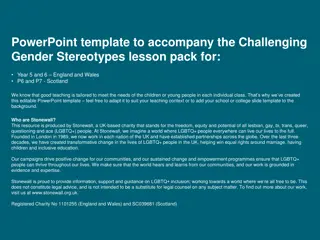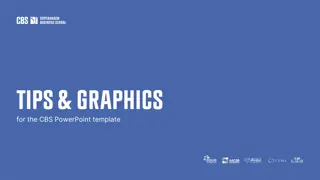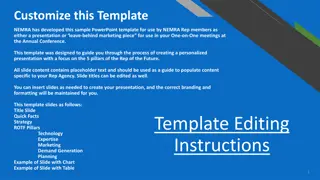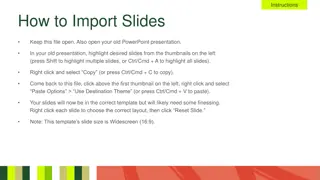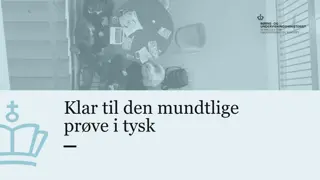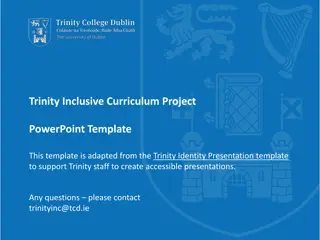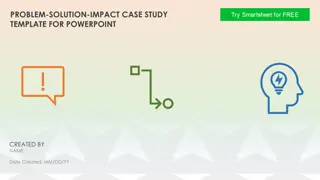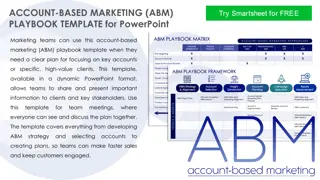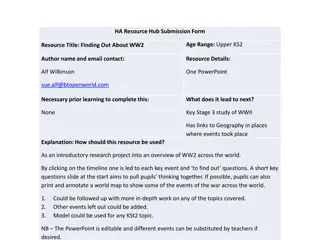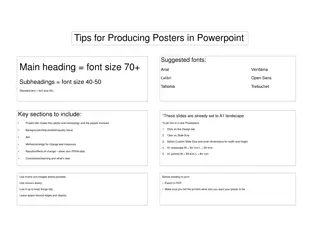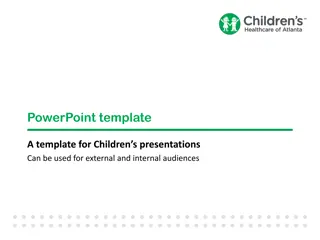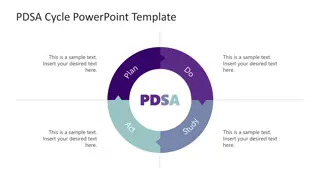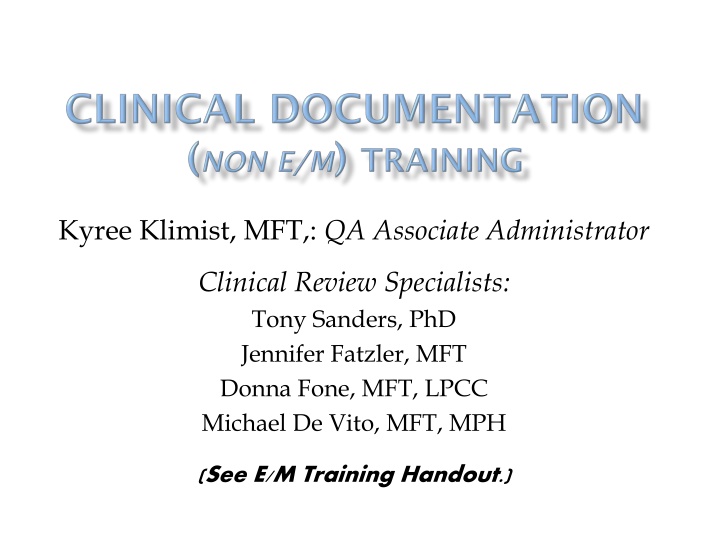
Medical Necessity Criteria in Mental Health Services
Explore the core elements of medical necessity, the clinical loop, and ways to assess, document client issues, and comply with regulations for specialty mental health services reimbursement through Medi-Cal in California.
Download Presentation

Please find below an Image/Link to download the presentation.
The content on the website is provided AS IS for your information and personal use only. It may not be sold, licensed, or shared on other websites without obtaining consent from the author. If you encounter any issues during the download, it is possible that the publisher has removed the file from their server.
You are allowed to download the files provided on this website for personal or commercial use, subject to the condition that they are used lawfully. All files are the property of their respective owners.
The content on the website is provided AS IS for your information and personal use only. It may not be sold, licensed, or shared on other websites without obtaining consent from the author.
E N D
Presentation Transcript
Kyree Klimist, MFT,: QA Associate Administrator Clinical Review Specialists: Tony Sanders, PhD Jennifer Fatzler, MFT Donna Fone, MFT, LPCC Michael De Vito, MFT, MPH (See E/M Training Handout.)
Discuss the core elements of Medical Necessity and the Clinical Loop aka Golden Thread Strengthen the ability to assess and document client problem areas, symptoms, strengths, and impairments in an Assessment. Improve the ability to develop client goals and mental health objectives in compliance with Medi-Cal/DHCS requirements. Learn how to document Medi-Cal/DHCS Progress Notes. 2
(See Scope of Practice Handout) LPHA Licensed LPHA Registered or Waivered _________________________________ MH Graduate Students _________________________________ MHRS _________________________________ Adjunct & Other Staff Consumer Workers Family Partners 3
Medical Necessity criteria for outpatient Specialty Mental Health Services are set forth in the California Code of Regulations, Title 9, Section 1830.205, 1830.210, and 1830.205 (b)(2)- (3). In order for outpatient Specialty Mental Health Services to be reimbursable through the Medi- Cal Program, all four of the required medical necessity elements must be applicable and be documented in the beneficiary s record. 4
Must meet the following: An included diagnosis (See Medical Necessity for Specialty Mental Health Services handout.) A qualifying impairment (meets one of the following) A significant impairment in an important area of life functioning A reasonable probability of significant deterioration in an import area of life functioning (without treatment) A reasonable probability that a child will not progress developmentally as individually appropriate 5
A qualifying Intervention (meets all of the following) The focus of the intervention is to address the condition of the impairment resulting from the included diagnosis The expectation is that the proposed intervention will: Significantly diminish the impairment, or Prevent significant deterioration, or Allow the child to progress developmentally as individually appropriate, or For a child who meet EPSDT criteria meet the criteria of Section 1830.210 The conditions would not be responsive to physical healthcare treatment. 6
It is very important to remember that the medical necessity criteria are INTERLOCKING. Covered Diagnosis Qualifying Impairment(s) The interventions/services which are billed to Medi- Cal must address the qualifying impairment(s) which result from the covered diagnosis. Interventions or services which address the impairment resulting from non-covered diagnoses are not reimbursable. See slides # 45 55. 7
This means that ALL SERVICES AND INTERVENTIONS FOR WHICH MEDI-CAL REIMBURSEMENT IS REQUESTED MUST DO ONE OF THE FOLLOWING: Diminish impairment(s) Prevent significant deterioration Allow a child to progress developmentally as individually appropriate 8
The initial & ongoing Assessment documentation establishes Medical Necessity. The Client Plans are based on the Initial Assessment and ongoing assessments. Progress Notes must contain evidence that the services claimed for reimbursement meet Medical Necessity. 9
Having a diagnosis that is not included does not exclude a client from having his/her services reimbursed AS LONG AS They also have an included diagnosis as the primary (FOCUS OF TX) diagnosis, and services/interventions are directed toward the impairment resulting from an included diagnosis. The primary diagnosis will be the diagnosis associated with a claim 10
You said youve been feeling very sad, anxious and irritable. How does this play out at home, at work, with friends? What do you think is making it difficult for you to do your work? take care of things at home? get along with others? do the things/activities that you once enjoyed? 11
How do your (depressive/anxious) symptoms impact your: (Social/family relationships) decreased contact with friends ? loss of intimate relationships? family relationships? (Performance at work or school) avoidance of certain jobs? being late to work due to depression? decreased contact with co-workers? failing grades due to depressive mood / poor concentration? (Participation in hobbies, leisure activities) avoidance of certain leisure activities? 12
Definition: The Golden Thread is the sequence of documentation that supports the demonstration of ongoing medical necessity and ensures all provided services are reimbursable. The sequence of documentation on which medical necessity requirements converge is: The Assessment The Client Plan The Progress Note 13
Medical Necessity: Completion of a Mental Health Assessment which documents: Symptoms/behaviors/impairments to determine a diagnosis Strengths/needs /barriers Carry Assessment information forward into the Client Plan which documents: Objectives linked to symptoms/behaviors/impairments Interventions to achieve the identified objectives Carry forward into the Progress Note which documents: Goal-based interventions provided to the client 14
What is the purpose? Learn about client s story Gather a lot of information about the client in a brief period of time in order to formulate a diagnosis, develop a conceptualization, and collaboratively create a treatment plan (acknowledged by client s signature). Determine if the client meets medical necessity: (Does he/she have an included diagnosis and an impairment in life functioning due to his/her mental health symptoms?) 15
Presenting Problems (symptoms/behaviors): Document the intensity, frequency, duration and onset of current symptoms/behaviors Impairments in Life Functioning: Document the connection between impairments and their relationship to MH symptoms/behaviors of the diagnosis e.g., difficulty keeping a job due to his depressed mood, lack of energy, and difficulties concentrating, which are significantly interfering with his work performance. Best practice to document both the client s activity level both prior to and at the onset of symptoms. 16
Assess for Substance Use Disorders (SUD): Document past and current use in record. For children/adolescents document caregiver s use and impact upon the client. If appropriate establish SUD Diagnosis Cannot be primary (FOCUS OF TX) Diagnosis Include in Client Plan by addressing the underlying MH Dx s signs, Sx, and behaviors through the MH Objectives. 17
Annual Assessments: As of 8/1/2014 full Assessments are required on an annual basis. See 9/3/14 BHCS Memorandum handout. 18
Initial Assessment must be completed within 30 days of the Episode Opening Date (EOD) based on a soft count. Annual Assessments after that must be completed within the 30 day period prior to the first day of the Episode Opening Month (EOM). E.G. Episode Opening Date (EOD) 8/28/14 and Assessment due by 9/27/14. Annual Assessment must be completed in July 2015 and signed no later then 7/31/2015 19
Who can: 1.) established a diagnosis, 2.) complete, & 3.) sign an Assessment? Licensed LPHA Who can: 1.) complete, 2.) and sign an Assessment but not provide a Diagnosis? Graduate Students with a co-signature of a licensed LPHA Must indicate in the Assessment which licensed LPHA provided the Diagnosis and the date it was assigned. Who can: 1.) complete and, 2.) sign an Assessment but requires a co- signature for the diagnosis given? Waivered LPHA, Registered LPHA MHRS may ONLY gather demographic & client reported information. Enter information into progress note, not into the assessment 20
If all information for the Initial Assessment is gathered in one assessment contact Reference Initial Assessment completed in the Progress Note Completed Initial Assessment (see Initial Assessment dated xx/xx/xx in clinical record) Sign/date the Assessment as of the date of the assessment contact If information for the Initial Assessment is gathered in multiple assessment contacts, Reference sections of the Initial Assessment completed in each Progress Note Sign/date the Assessment as of the date of the last assessment contact 21
If information is gathered AFTER the initial assessment has been completed, an Assessment Addendum MUST be used instead of adding to the original Assessment An Assessment Addendum should be used to update/confirm information on the original Assessment. 22
Primary Diagnosis is the Medi-Cal Included diagnosis that is the PRIMARY FOCUS OF TREATMENT. The Primary diagnosis in the clinical record must match the primary diagnosis in INSYST to ensure an accurate clinical snapshot If the Diagnosis is revised you must update INSYST 23
What is the purpose? Ensures a client s care is goal directed and purposeful Allows anyone involved in a client s care to see, at a glance, what a client s services are aimed at and directed toward Creates a road map for the client, family, and mental health / medical staff Lists markers of progress; Is the client getting better? Is the client stabilizing? Is the client progressing developmentally as appropriate? 24
Treatment Plan Cycle: As of (8/1/2014) treatments plans will only be required on an annual basis. The cycle must be kept in sync with the Episode Opening Date (EOD). Every Treatment Plan after that would be due on a 12 month cycle, completed within the 30 day period prior to the first day of the EOD month. 25
Charts will enter the Annual cycle when they reach the anniversary of the episode opening date (EOD) month. A chart opened on 12/15/13 will convert to an Annual Cycle on 12/1/14. An Annual Assessment & Treatment Plan will be completed in November 2014. 6-month Cycle: 12/15/13 5/31/14 & 6/1/14 11/30/14 Annual Cycle: 12/1/14 -11/30/15 A chart opened on 7/1/2014 will convert to an Annual Cycle on 7/1/15. A 6-month update will continue to be required in December. An Annual Assessment & Treatment Plan will be completed in June. 6-month Cycle: 7/1/14 12/31/14 & 1/1/15 6/30/15 Annual Cycle: 7/1/15 -6/30/15 26
Providers MUST be attentive to the need to update changes in the treatment plan through-out the year. DHCS (and QA) will disallow notes if the treatment plan has not been updated to reflect new client goals, mental health objectives, and events in the client s life. Examples of events requiring a change to the Treatment Plan include, but are not limited to: hospitalization, new thoughts or behaviors of self-harm or dangerousness to others, additions of new treatment modalities (i.e. case management or groups.) 27
In addition, it is strongly recommendedthat charts are reviewed at 60 days after the EOD to ensures that the Assessment and the Treatment Plan has been thoroughly completed with all signatures, and on time. (This is not necessarily a full Quality Review and is not triggered by the 485 InSyst report.) If you skip this review and only do it annually and one of these items is missing, the financial repercussions can be heavy. 28
Must be completed: Within 60 days (actual day count starting on EOD. EOD 8/18/14, then the Plan is due: 10/16/14 The 2nd treatment plan is due approximately 10 months after the first treatment plan during the month prior to the EOD. Every Treatment Plan after that would be on a 12 month cycle. A Client Plan is due annually before the first day of the first month of the EOD, and annually thereafter. 29
Goals The Client Goals are the long-term hopes of the consumer and/or caregiver/parent . Goals should focus upon their personal vision of recovery, wellness, and the life they envision for themselves. You may include Long Term Mental Health Goals which support the Client Life Goals (by linking them to the specific MH Objectives, see slides 46 57). Invaluable for client engagement and buy-in to services. Providers assist the client in developing the short term Mental Health objectives to his/her long term goal which are targets of interventions. 30
Mental Health Objectives A way to see if the CLIENT is improving Measurable change in helping the client achieve his/her long- term goals Can address symptoms, behaviors or impairments identified in the Assessment Strength based MH objectives replace problematic Sx with positive coping skills/behaviors/etc. Should be based upon the client s abilities and be meaningful to the client What is he/she identifying as the problem? Why did he/she reach out for help? SMART (Specific, Measurable, Attainable, Realistic and Time- Bound) Important to look at how they might impact and build upon strengths and supports 31
Service Modalities Identify the proposed type(s) of service modalities to be provided along with a proposed frequency and duration. Example: Individual Psychotherapy 1x per week, or as needed, for 12 months; Case Management 1x per month, or as needed, for 12 months; Group Therapy 1x per week ( or as needed probably not necessary here as all groups are scheduled), for 12 months. Adding as needed to the frequency of the service modality allows flexibility in the scheduling. 32
Interventions For each service modality include a detailed description of interventions to be provided i.e. CBT, DBT, mindfulness/stress reduction, self-regulation skills Interventions must focus upon and address the identified functional impairments as a result of the mental disorder. Interventions must be consistent with the client plan mental health objectives and the qualifying diagnoses 33
Plans MUST be updated as client functioning improves or deteriorates. Events may trigger the need such as a psychiatric hospitalization. DHCS is now disallowing all claims after the date the Plan should have been updated. All signatures are required on any addendum to a current Client Plan. (i.e. All required staff signatures & client signature) 34
If the client does not sign or refuses to sign the Client Plan, regular efforts must be attempted to obtain the client s approval. Note the issue on the client signature line in the Client Plan with a reference to a Progress Note. Then elaborate in the Progress Note the rationale or reason why a signature was not obtained. DHCS is now disallowing all notes after date Plan should have been signed by the Client. 35
Example - Symptoms / behaviors / impairments related to the primary diagnosis (from the Assessment) For the past month, client has been experiencing depressed mood with a loss of energy, loss of interest or pleasure in almost all activities, and social withdrawal Depressive symptoms are significantly interfering with client s academic/work performance, and impacting his social and family relationships 36
Example MH OBJECTIVE targeting symptoms Client Goal: I want to be able to go out do things with my family & friends, again Mental Health Objective: To decrease depressive symptoms as evidenced by an increase in the # of social interactions from 0x to 3x per week in the next # weeks/months Service Modalities Individual Rehabilitation (weekly or as needed), & Psychiatric Medication Services (monthly or as needed) over the next 12 months Detailed Clinical Interventions: Assist the client in re-engaging in pleasant activities and learning new ways of dealing with distress Teach and reinforce active problem-solving skills in order to increase client s self-efficacy and improve his/her mood. Help the client to identify early warning signs of relapse, review skills learned during therapy, and develop a plan for managing challenges in order to help prevent the relapse of depressive symptoms. 37
Verb Measure Target Person Client s Behavior Baseline Measure Goal Measure Time Frame To Increase # of min s Client Engages in pleasurable activities (social, physical, pleasant) From 0x/day To 30 /day Within 12 mos. To Increase # of times Client Uses active problem-solving Skills From 0x/week To 5x/week Within 12 mos. To Increase # of times Client Uses relaxation skills From 0/week To 5x/week Within 12 mos. 38
Exercise: Turn to the person sitting next to you and together create a scenario including the following: Included Dx; Signs, Sx and Bx of Dx; Impairments; and then write a SMART MH objectives such as: Insomnia (Sx of depression) Improved ability to fall asleep within 30 minutes of... going to bed from 0 times per week to 5 times per week within the next 12 months. Improved ability to stay asleep at least 6 hours once having fallen asleep from 0 times per week to 5 times per week within the next 12 months. Decreased Appetite (Sx of depression) Improved appetite as evidence by eating two or three meals per day from 1 times per week to 5 times per week within the next 12 months. Anergy (Sx of depression) Improved energy as evidenced by leaving the home for outside activities 3 or more times per week, from 1 time every two weeks, within the next 12 months. Poor self-care/ADL s (Impairment of depression) Improved ability to care for self by showering or bathing 3 4 times per week, from 1 time per week, within the next 12 months. 39
Exercise: Break into groups and write SMART objectives: Inability to maintain housing/placement (address underlying MH Sx s) 1) Inability to (or maintain) study/work (behavior, attendance, achievement, functioning) (address underlying MH Sx s) 2) Intrusive thoughts 3) 40
Exercise: Break into groups and write SMART objectives: Thoughts (or actions) of... self/other harm 4) Hallucinations (visual/auditory) 4) Phobia/Anxiety as evidence by (or self- report of...) 5) 41
Exercise: Break into groups and write SMART objectives: 7) Concentration as evidence by (or self-report of...) 8) Inattentionas evidence by (or self-report of...) 9) Oppositional Behavior (provide example such as re compliance with authority) 42
Exercise: Break into groups and write SMART objectives: Anger Control as evidence by . (or self report of...) 10) Conduct/Anti-social Behaviors (shoplifting, lying, vandalism, cruelty to animals, etc.) 11) Behavioral Regression as evidenced by . (or caretaker report of... ) 12) 43
Exercise: Break into groups and write SMART objectives: 13) Legal Problems (Address underlying MH symptomology) Family/Relationship Problems (Address underlying MH symptomology) 14) Substance use habits as evidence by (Address underlying MH symptomology) 15) 44
Non-billable example: Mental Health Objective: Client will obtain stable housing within 6 months; temporarily living with a friend. Service Modality: Case management 1x/week or as needed for 1 year Detailed Interventions: Case management - Case manager will work with client to apply for housing and assist client in filling out necessary forms. 45
Billable example: Dx: Major Depressive DO (lack of interest in all areas of life, low energy, insomnia, indecisiveness, feelings of worthlessness, and poor self-care) Goals: Client states: I want my own place to live . Long Term MH Goal: Decrease depression symptomology, and increase coping, so that client s depressive signs and symptoms do not negatively impact his ability to obtain housing. 46
Billable example cont.: Mental Health Objective(s): -Client s depressive symptoms are reduced as evidenced by an increase in sleep from 2-3 hours per night to 6-8 hours per night by 6 months; and an increase in energy from 0 energy now to 6-8 on a 0-10 scale (10 being high energy) per self-report by 6 months. -Client is engaged and invested in his self-care as evidenced by increased # of showers per week from 0 to 2 or more; and increased brushing of teeth from 0x daily to once daily within the next 6 months. -Client s lack of interest and indecisiveness will decrease as evidenced by an increase in action steps taken by client towards obtaining stable housing from 0 to 4 or more action steps taken within the next 3 months. 47
Billable example cont.: Service Modality: Psychotherapy 1x/week, or as needed, for 1 year; Case Management 1x/week, or as needed, for 1 year; Group Rehab 1x/week for 6 months Detailed Interventions: Psychotherapy CBT to help client link feelings of worthlessness to depressive symptoms, to explore roots of low self-esteem and areas of competence. Group Rehab build client s awareness to track and manage depressive symptoms, teach coping skills such as relaxation techniques, and build client s self-care skills. Case Management Link client to psychiatric services. 48
Non-billable example: Mental Health Objective: Client will obtain stable housing within 6 months; temporarily living with a friend. Service Modality: Case management 1x/week or as needed for 1 year Detailed Interventions: Case management - Case manager will work with client to apply for housing and assist client in filling out necessary forms. 49
Billable example: Dx: Schizophrenia Paranoid delusions, paranoid auditory hallucinations with negative symptoms of flat affect, poor planning and follow-through which results in: social withdrawal, lack of motivation (such as ability to attend desired vocational services) and neglect of personal hygiene. Goal: Client states: I want a job so that I can support myself . Long Term MH Goal: Decrease positive and negative signs of schizophrenia so that they do not interfere with the client s ability to obtain and maintain meaningful employment. 50

